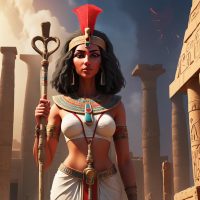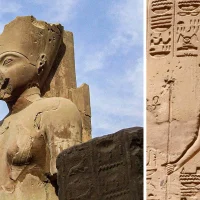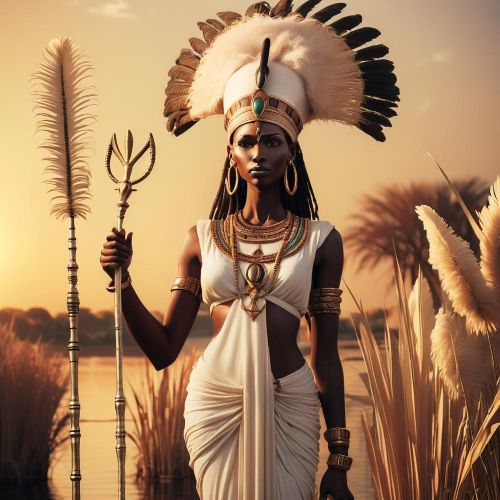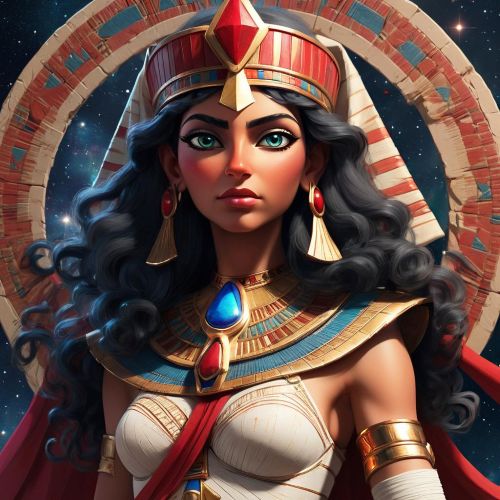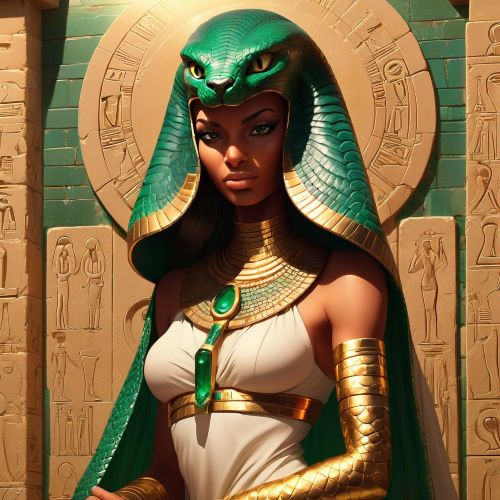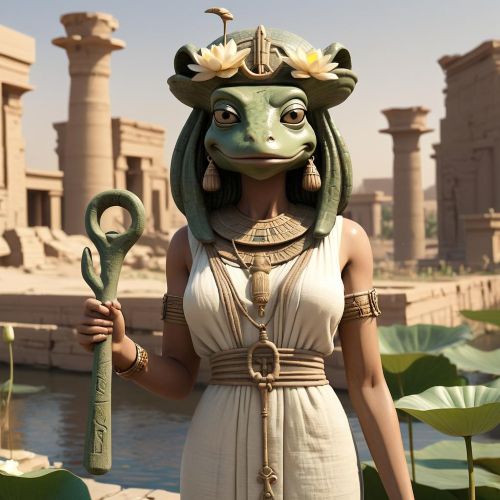Amunet : Goddess of Invisibility
Listen
At a glance
| Description | |
|---|---|
| Origin | Egyptian Mythology |
| Classification | Gods |
| Family Members | N/A |
| Region | Egypt |
| Associated With | Invisibility, Thebes |
Amunet
Introduction
Amunet, whose name means “The Hidden One,” was one of the earliest goddesses to emerge in ancient Egyptian mythology. She belonged to the Hermopolitan Ogdoad, a group of eight primordial deities who symbolized the elemental chaos that existed before creation. As the feminine counterpart of Amun, she embodied invisibility, air, and the mysterious forces that work beyond human sight. In the earliest Egyptian religious thought, she was not just a passive partner but a vital force that contributed to the emergence of life and order from primordial darkness. While later Egyptian theology gave more prominence to deities like Mut, Hathor, and Isis, Amunet retained a foundational role in Egypt’s cosmology, particularly in Thebes where she was honored in connection with royal rituals.
Physical Traits
The artistic portrayals of Amunet emphasize both her primordial origins and her protective role. She is often shown as a regal woman crowned with the Red Crown of Lower Egypt, symbolizing guardianship and sovereignty. Some depictions give her a staff or an ankh, signifying power and eternal life. In more esoteric contexts, Amunet appears with serpent-like features or as a snake-headed woman, reflecting her association with transformation, renewal, and the hidden forces of nature.
At Hermopolis, a few representations show her in frog-headed form, consistent with the imagery of the Ogdoad deities, who were sometimes depicted as frogs and serpents to reflect fertility and the primal waters. The association with snakes and frogs links her directly to themes of rebirth and creation. Unlike more anthropomorphic goddesses, Amunet’s imagery often stresses her connection to the unseen world, where air, wind, and invisibility take precedence over form.
A fascinating historical discovery also deepens her mystique. Archaeologists uncovered the mummified remains of a priestess named Amunet from Egypt’s 11th Dynasty at Deir el-Bahari. She bore intricate tattoos across her body, including on her abdomen and thighs. These tattoos, which resemble patterns found on Middle Kingdom figurines, likely had ritual significance tied to fertility, healing, and protection. Though this priestess is not the goddess herself, the connection suggests how Amunet’s cult inspired priestesses who embodied her power in ritual life.
Family
In Egyptian cosmogony, Amunet is paired with Amun as part of the Ogdoad, the eight gods who represented the formless elements that existed before the world. Each pair embodied a dual principle: male and female, active and passive, seen and unseen. Together, Amun and Amunet symbolized the hidden power of air and the breath of life.
Over time, Amun gained prominence as one of Egypt’s great state gods, particularly during the New Kingdom, and was eventually merged with Ra as Amun-Ra. In this transition, Amunet’s role as his consort was gradually replaced by Mut, who became the more prominent goddess in Thebes. However, Amunet’s identity as a primordial partner was never erased. In certain inscriptions, she appears alongside other great mother figures such as Neith and Hathor, and in funerary texts, she was sometimes merged with Imentet, the goddess of the West, linking her to the afterlife.
Though she does not appear in myths as a mother to specific divine children, Amunet carried a maternal archetype, especially in coronation rituals where she bestowed protection on new pharaohs. In this sense, she was less a biological mother and more a cosmic guardian, ensuring that the divine order was passed on to Egypt’s rulers.
Other names
Amunet is known by several variations of her name, reflecting Egypt’s regional diversity and the fluidity of religious traditions. She is sometimes called Amaunet, Amonet, or Imnt, with all forms retaining the root meaning of concealment or hiddenness. In certain contexts, she is also connected with Amentet or Imentet, “She of the West,” highlighting her association with the afterlife and the hidden realm of the dead.
Her epithets reveal her significance: she is “Amunet the Great,” “Lady of Heaven,” “Mother who is Father,” and “The Invisible One.” These titles stress her role as both creator and protector, embodying mystery, maternal strength, and the unseen forces that sustain creation. Such names helped distinguish her from later goddesses while preserving her identity as an ancient and powerful divine presence.
Powers and Abilities
Amunet’s powers revolve around invisibility, creation, and divine protection. She personified the unseen air and the hidden currents of life that move the cosmos. As part of the Ogdoad, she and Amun were believed to have helped generate the cosmic egg from which the sun god Ra emerged, initiating the cycle of creation. This gave her an essential role as a primordial mother figure, even if later myths did not emphasize her as much as Isis or Hathor.
Her protective qualities were especially valued in royal rituals. During pharaonic coronations, Amunet was invoked as a guardian of kingship, ensuring that the ruler carried the legitimacy of divine order. She also represented intuitive knowledge and the wisdom hidden from ordinary human sight, making her a patron of mysteries and esoteric learning.
Another important dimension of her power lay in funerary contexts. Her identification with the West connected her to the setting sun and the realm of the dead, where she welcomed souls into the afterlife. In this way, she was both a creator of beginnings and a protector at the threshold of endings.
Modern Day Influence
Although Amunet is not as prominent today as figures like Isis or Osiris, she continues to capture imagination in both scholarship and popular culture. Egyptologists study her as a key figure in the Hermopolitan Ogdoad, emphasizing her role in the earliest stages of Egyptian religious thought. Discoveries like the tattooed priestess Amunet have deepened modern understanding of the importance of female ritual specialists and the connection between goddesses and living women in ancient cult practices.
In popular culture, Amunet’s name and essence have been reinterpreted in new ways. She has appeared in literature, television, and films, often reimagined as a mysterious or even sinister figure. The 2017 film The Mummy used the name Amunet for its antagonist, though this was a fictionalized version rather than a faithful representation of the goddess. Video games like Assassin’s Creed Origins also incorporate Amunet as a symbol of hidden power, blending historical inspiration with creative storytelling.
Her name is even used in modern spiritual and esoteric circles, where she represents hidden wisdom, feminine mystery, and protection. Jewelry and art inspired by her symbolism often emphasize air, invisibility, or serpent imagery. Artists and performers adopting the name Amunet highlight themes of transformation, secrecy, and creation, showing how the goddess continues to inspire modern creativity.
Even though she does not enjoy the global recognition of Isis or Hathor, Amunet’s allure lies in her mystery. As the embodiment of what is unseen, she speaks to timeless human fascination with the hidden forces that shape existence. Her legacy as “The Hidden One” ensures that she remains a compelling figure, both in the study of Egyptian mythology and in the imagination of those seeking meaning in the unseen.
Related Images
Source
Hart, G. (2005). The Routledge Dictionary of Egyptian Gods and Goddesses. Psychology Press.
Pinch, G. (2002). Handbook of Egyptian Mythology. ABC-CLIO.
Klotz, D. (2012). Caesar in the City of Amun: Egyptian Temple Construction and Theology in Roman Thebes. Brepols.
Ritner, R. K. (1993). The Mechanics of Ancient Egyptian Magical Practice. Oriental Institute, University of Chicago.
Project Amunet | EES. (2025). Egypt Exploration Society.
UCL Museums. (2012). Tattooed Mummy Amunet. UCL Researchers in Museums.
Ammunet: Goddess of Hidden Power & Mystery. (2025). Talestone Publishing.
Amunet: The Fascinating Goddess “Mother Who Is Father”. (2021). TheCollector.com.
Wikipedia contributors. (2023). Amunet. Wikipedia. https://en.wikipedia.org/wiki/Amunet
World History Edu. (2021, August 26). Egyptian goddess Amunet: Origin story, meaning, birth, family, powers, & importance. https://worldhistoryedu.com/amunet-egyptian-goddess-origins-powers-symbols-family/
Frye, A. (2021, July 12). Amunet: The fascinating goddess ‘Mother Who Is Father’. TheCollector. https://www.thecollector.com/amunet-egyptian-deity-goddess/
Wilkinson, R. H. (2003). The Complete Gods and Goddesses of Ancient Egypt. Thames & Hudson.
Assmann, J. (2001). The Search for God in Ancient Egypt. Cornell University Press.
Hornung, E. (1999). The Ancient Egyptian Books of the Afterlife. Cornell University Press.
Shaw, I., & Nicholson, P. (1995). The Dictionary of Ancient Egypt. British Museum Press.
Frequently Asked Questions
What is lorem Ipsum?
I am text block. Click edit button to change this text. Lorem ipsum dolor sit amet, consectetur adipiscing elit. Ut elit tellus, luctus nec ullamcorper mattis, pulvinar dapibus leo.
What is lorem Ipsum?
I am text block. Click edit button to change this text. Lorem ipsum dolor sit amet, consectetur adipiscing elit. Ut elit tellus, luctus nec ullamcorper mattis, pulvinar dapibus leo.
What is lorem Ipsum?
I am text block. Click edit button to change this text. Lorem ipsum dolor sit amet, consectetur adipiscing elit. Ut elit tellus, luctus nec ullamcorper mattis, pulvinar dapibus leo.
What is lorem Ipsum?
I am text block. Click edit button to change this text. Lorem ipsum dolor sit amet, consectetur adipiscing elit. Ut elit tellus, luctus nec ullamcorper mattis, pulvinar dapibus leo.
What is lorem Ipsum?
I am text block. Click edit button to change this text. Lorem ipsum dolor sit amet, consectetur adipiscing elit. Ut elit tellus, luctus nec ullamcorper mattis, pulvinar dapibus leo.


